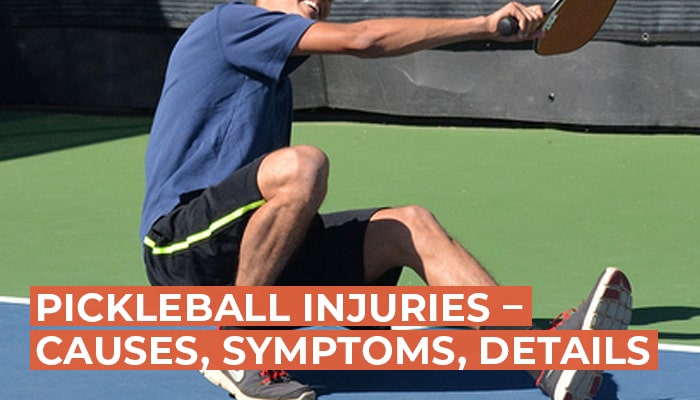Pickleball injuries are not rare. Due to its soaring popularity, more people are playing pickleball and more injuries are being reported. But usually, they are not so precarious. I am writing about this because I want people to be aware of the types of pickleball injuries that can occur while playing pickleball.
Pickleball injuries are not prevalent, but they do happen. The most common pickleball injuries affect the knee, feet, or the eye. All of these lacerations can be prevented by taking adequate precautions and using favorable techniques and pickleball gear.
Here is an overview of common pickleball injuries:
🔺 Pickleball Knee Injuries:
The most common pickleball injury is to the knee. This is because a lot of side-to-side movement is required in the sport. This constant motion can lead to wear and tear on knee cartilage.
The game requires players to move quickly, including lunging and diving for a pickleball. This places extra strain on the knees. Sudden changes in direction also put people at risk of pickleball knee injuries.

Plus, if you are coming down from hitting a ball and are not balanced, it could mean landing wrong on your knee or twisting your knee in an unnatural way, both leading to injury.
The broadly popular type of knee injury in pickleball is injuries from twisting on the court ground. Some common pickleball knee injuries include:
Achilles tendonitis is also a problem for pickleball players as it results from the same sort of side-to-side movements as knee problems.
Meniscus tears can occur from an abrupt twisting motion or a direct blow to the knee joint resulting in pain, swelling, catching, or locking sensations within the knee joint itself with a limited range of motion. Patellofemoral pain syndrome (PFPS), causes pain or discomfort around the kneecap (patella).
🔺 Pickleball Eye Injuries:
Pickleball Eye injuries are less common than knee injuries, but they still happen fairly often on the pickleball court. This is due to small pieces of gravel or sand getting in your eye while you’re playing. It could also be caused by a ball hitting you in the eye or another accident with equipment such as a paddle hitting you in the face.
🔺 Pickleball Arm and Shoulder injuries:
The most common arm injuries are those that affect the fingers, hand, and wrist. The finger is injured most often by the impact of the paddle on the finger or by entrapment of the finger between the ball and the opposing player’s paddle. Swelling and pain are generally present along with possible bruising or deformity of the joint. X-rays are taken to rule out any fractures or breaks in the finger or wrist bones.
🔺 Pickleball wrist Injuries:
The most common pickleball injury is a wrist sprain, which occurs when the ligaments that connect your forearm to your hand are stretched or torn. This can occur when you tumble on an outstretched arm. Wrist sprains cause pain, swelling, bruising, and loss of motion in your wrist. Resting your wrist and involving ice packs to lessen pain and swelling will help rejuvenate the injury.
Wrist Injuries Tendinitis – this is a common pickleball injury for pickleball players because they use their wrists so much when they play. This can cause a rash and lump of the tendons making it painful to move your wrist.
To treat this injury you should ice it to reduce the swelling and take anti-inflammatory medication. To prevent this type of injury you should stretch before playing to warm up your muscles and use a wrist brace while playing to support your wrist.
🔺 Pickleball Hand injuries:
Hands are most at risk while playing pickleball. Even inactive hand injuries are also very common. Here I am discussing only the main types for your assistance.
Popular pickleball hand injuries include the following ones:
Pickleball elbow: This is an unfortunate situation that occurs when tendons in your elbow are overloaded, usually by repetitive motions of the wrist and arm.
Fractures: These are extremely painful and need medical attention.
Hand sprains and strains: Overstretching or tearing of the ligaments can cause pain, swelling, inflammation, and muscle spasms.
Carpal tunnel syndrome (CTS):
This syndrome can result in discomfort, numbness, tingling, and weakness in the hand or fingers. It occurs when a nerve in your wrist is compressed or squeezed by surrounding tissue.
🔺 Pickleball Foot Injuries:
Pickleball foot injuries are common and can be serious. These injuries can lead to permanent abnormality if left untreated. Many pickleball players suffer from pickleball foot problems such as athlete’s foot and plantar fasciitis.
An athlete’s foot is a fungal infection caused by a fungus that grows on or in the top layer of skin of your feet or other parts of your body.
Plantar fasciitis is a rash of the ligament (the plantar fascia) on the underside of your foot.
The most common pickleball foot injury is a sprain. This occurs when the ligaments that attach to your bones are stretched or ripped. Sprains can happen when you land awkwardly after jumping to hit a ball or if you step on another player’s foot during play.
Foot sprains cause pain, swelling, and bruising around the injured area as well as loss of motion in your foot. The treatment contains sloping your foot and applying ice packs to ameliorate pain and swelling.
Your doctor might also recommend wearing a splint or brace to keep the joint immobile while it heals. Other foot injuries include stress, fractures, ankle sprains, and heel pain.
🔺 Typical Pickleball Injuries:
The most typical pickleball hand injury is caused by gripping the paddle too tightly. It’s also possible to injure your wrist if you follow through improperly on your swing. Other hand-related injuries include calluses and blisters.
Even though you don’t have to run fast in pickleball, your feet can still get sore and tired after a long match. You may also experience plantar fasciitis, pain in your arches, or other foot issues.
🔺 How to prevent pickleball injuries?
Injuries can typically be prevented by using proper technique, wearing appropriate equipment, and gradually increasing activity levels.
When you are playing, it is better to wear protective eyewear. This can help prevent injuries to your eyes, as well as many other injuries like cuts and bruises on your body.
Pickleball Knee injuries are another common concern, especially among pickleball players. Different types of knee injuries can occur while playing pickleball, and there are ways to prevent them from happening. You might be able to avoid some of these injuries by wearing proper footwear, but others will require more serious treatments from doctors.
Here are some tips for preventing injuries in pickleball:
To treat this injury you should rest it for at least two days then ice it, compress it with an ace bandage, and elevate it above your heart level whenever possible.
🔺 Cure Pickleball Injuries Wisely
Having a sound knowledge about pickleball injuries help you understand the illness and get that treated easily. Taking proper care after suffering from an injury is crucial. Because if left untreated, these injuries can lead to permanent disabilities or lack of movement.
Understanding all above knee, shoulder, and arm injuries helps every player keep a record of their health and improve their skill level in pickleball. Typically people used to suffer from serious pickleball injuries but now markets are full of protective pickleball gear and accessories. These accessories help us avoid serious pickleball injuries.
Stay connected with this website to enhance your knowledge of the sport.

